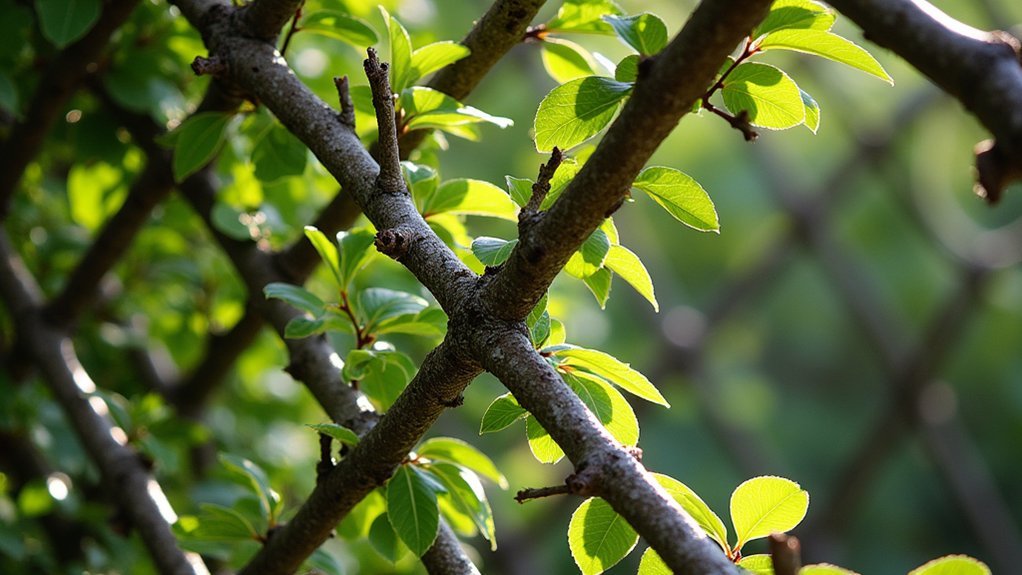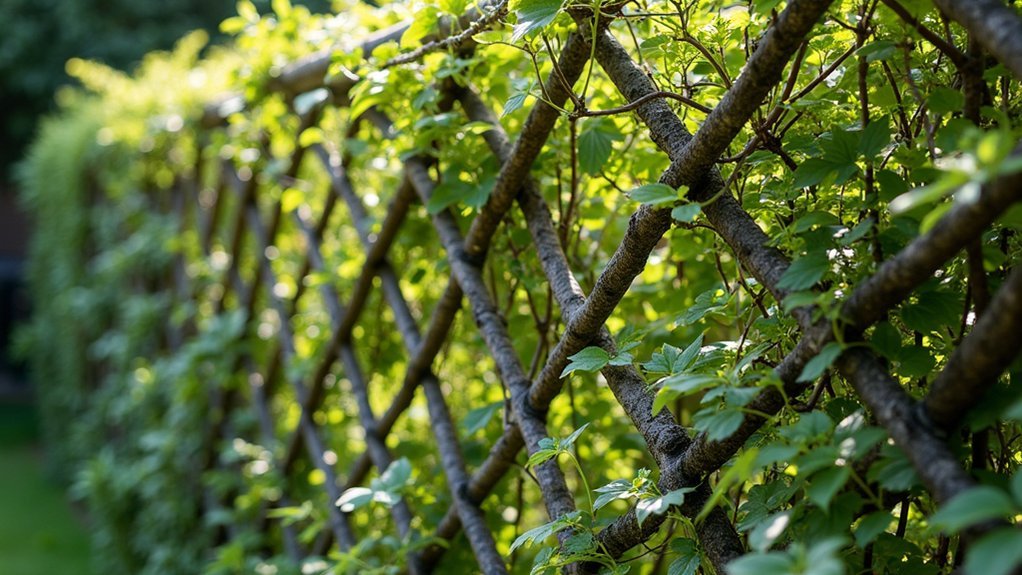A Belgian fence espalier pattern is a space-saving fruit tree training technique featuring trees grown in a diagonal lattice or diamond pattern against a support structure. You’ll create this decorative living fence by weaving branches at 45-degree angles to form an interlaced pattern that maximizes both aesthetics and fruit production. It’s perfect for small gardens, allowing multiple varieties in minimal space. The technique transforms ordinary walls into productive growing areas with visual appeal that changes through the seasons.
The Origin and History of Belgian Fence Espalier

While many gardening techniques have evolved over centuries, the Belgian fence espalier stands out as a particularly ingenious innovation from Belgium’s agricultural tradition. This distinctive method was developed specifically to grow fruit trees in limited spaces while maintaining both productivity and visual appeal.
The Belgian fence pattern features a lattice-like arrangement where branches are trained horizontally, creating a living fence that’s both functional and decorative.
This space-efficient technique has ancient roots, with evidence suggesting that similar espalier methods were employed in Roman gardens for practical and ornamental purposes.
You’ll find that throughout history, these espaliers provided gardeners with a clever solution for maximizing fruit production in confined areas while ensuring easy harvesting—a balance of utility and beauty that continues to inspire modern gardeners.
Key Features and Benefits of Belgian Fence Design
The Belgian fence espalier pattern offers a remarkable space-saving solution for your garden, transforming ordinary walls or boundaries into productive growing areas.
You’ll appreciate how the interwoven branches create a stunning decorative lattice that bears fruit right where you can easily harvest it.
This dual-purpose design not only maximizes your garden’s aesthetic appeal but also increases fruit yield in spaces where traditional orchards wouldn’t fit.
Space-Saving Structure
When garden space becomes limited, Belgian fence espalier patterns offer an ingenious solution that maximizes vertical growth while minimizing horizontal footprint.
You’ll appreciate how this lattice-like structure allows trees to grow upward rather than outward, making it perfect for small yards, narrow borders, or urban gardens.
The space efficiency of a Belgian fence comes from:
- Strategic spacing – Trees planted approximately 18 inches apart create a living fence while ensuring each plant receives adequate sunlight.
- Vertical training – Fruit trees grow along a structured framework rather than spreading outward, saving valuable garden real estate.
- Minimal materials – You’ll need just two cedar posts and agricultural fencing to support multiple trees in a fraction of the space traditional orchards require.
This efficient design means you can grow several fruit varieties in the space of a single conventional tree.
Decorative Fruiting Pattern
Visually stunning and productive, Belgian fence espaliers transform ordinary fruit trees into living works of art through their distinctive lattice design. You’ll create an eye-catching focal point while maximizing your harvest in limited space. The interwoven branches form a structured pattern that’s both functional and beautiful.
| Feature | Benefit |
|---|---|
| Lattice design | Enhances sun exposure and airflow |
| 18-inch spacing | Perfect for small gardens and urban settings |
| V or Y-shaped training | Creates striking visual impact |
| Spur-bearing fruit tree compatibility | Guarantees productive harvests |
| Different varieties placement | Allows cross-pollination in one structure |
With proper training, your Belgian fence will mature in about three years. You can mix different varieties of apples or pears within your fence, providing both visual diversity and practical benefits of cross-pollination while maintaining the elegant lattice appearance.
Selecting Suitable Trees for Your Belgian Fence

Selecting the perfect apple varieties for your Belgian fence begins with choosing compatible, spur-bearing cultivars like Honeycrisp and Pioneer Mac that guarantee cross-pollination success.
You’ll want to focus on young, healthy whips with ½ to ¾ caliper and grafting points below the cut line for ideal training potential.
Training these slender trees early in their development establishes the distinctive diamond pattern that makes Belgian fences both functional and visually striking.
Optimal Apple Varieties
Success in creating a thriving Belgian fence espalier begins with choosing the right apple varieties. Spur-bearing cultivars like Honeycrisp offer excellent cold-hardiness and flavor while adapting perfectly to the trained pattern.
Always select dwarf or semi-dwarf rootstocks, as they’re easier to maintain and still produce abundant fruit while conforming to your space constraints.
For ideal results:
- Mix compatible pollinators – varieties like Fuji and Gala bloom alongside Honeycrisp, enhancing fruit set through cross-pollination.
- Choose varieties with similar growth habits – Pioneer Mac pairs well with other dwarf types, maintaining aesthetic uniformity.
- Match flowering times carefully – synchronized blooming ensures effective pollination and maximizes your harvest potential.
Training Young Whips
The foundation of a stunning Belgian fence espalier lies in choosing the right young whips.
Select six young trees to be planted with a caliper of ½ to ¾ inches, ideally from dwarf or semi-dwarf rootstock that won’t outgrow your space.
Spur-bearing apple or pear varieties work best for this pattern as they fruit on older wood, maximizing your harvest.
Ascertain your selections are cross-pollination compatible if you’re using multiple cultivars.
Examine each whip carefully for health and check that the grafting point sits below where you’ll make training cuts.
Space trees 18 inches on center when planting to allow proper development of the lattice pattern.
With well-prepared soil and proper spacing, your young whips will be perfectly positioned to be trained into the classic Belgian fence formation.
Essential Materials and Tools for Construction
Before starting your Belgian fence espalier project, you’ll need to gather specific materials and tools to guarantee proper construction.
The essential materials include six trees with ½ to ¾ inches caliper, preferably dwarf or semi-dwarf varieties, along with two 4 x 4 cedar posts and eight feet of hogwire to create your support structure.
Your toolbox should contain:
- A hammer and drill for secure assembly
- A table saw with dado blade for cutting post notches
- Blue plastic tape and gridded paper for planning
Don’t forget additional supplies like nails and screws for fastening components.
Remember to select a full-sun location and prepare the soil properly. These materials and tools will assure your Belgian fence espalier develops into the distinctive lattice pattern that makes this technique so visually appealing.
Step-by-Step Guide to Creating the Diamond Pattern

With your materials and tools ready, we’ll now build the distinctive diamond pattern that defines the Belgian fence espalier. Begin by measuring your space and creating a grid on paper, ensuring trees are planted 18 inches apart. Set your cedar posts 8 feet apart in gravel, with notches cut lengthwise for stability.
| Stage | Action | Purpose |
|---|---|---|
| Layout | Draw grid pattern | Plan tree spacing |
| Posts | Install 4×4 cedar posts | Create framework |
| Wire | Stretch taut between notches | Provide support |
| Planting | Position trees 1 foot from wire | Allow growth room |
| Training | Tie stems and prune strategically | Form diamond patterns |
Select trees grown on dwarf or semi-dwarf rootstock with ½ to ¾ inch caliper. As they grow, tie the main stems to your support wires and prune above outward-facing buds to maintain your elegant diamond patterns.
Seasonal Maintenance and Pruning Techniques
Maintaining your Belgian fence espalier requires consistent attention throughout the growing season, as regular pruning forms the backbone of successful pattern development. During summer months, you’ll need to prune every couple of weeks, focusing on cuts above outward-facing buds to direct growth properly.
Your regular maintenance should include:
- Tying new growth to the support structure, allowing enough flexibility for branch development without restriction.
- Monitoring water and nutrient needs, as closely planted trees compete for resources.
- Pruning to maintain the diamond pattern by removing unwanted shoots and trimming branch ends.
After the first three years, maintenance becomes less intensive, but you’ll still need to apply these pruning techniques to preserve your Belgian fence’s distinctive form and guarantee continued health of your espaliered trees.
Spacing and Design Variations for Different Spaces

Although the classic Belgian fence espalier follows traditional spacing guidelines, you’ll find numerous variations that can adapt to your specific garden constraints and aesthetic preferences. The standard 18-inch spacing creates the traditional lattice pattern, but you can adjust this measurement based on your available area and the trees you’ve selected.
Belgian fence espaliers offer flexible spacing options beyond the traditional 18-inch standard to accommodate your garden’s unique dimensions and design vision.
For compact gardens, consider dwarf varieties that won’t overwhelm the space even as each branch reaches the top of your support structure. The overlapping V or Y design variations allow for creative interpretations while maintaining essential airflow and sunlight exposure.
If you have more room, free-standing Belgian fence patterns create striking living barriers that serve both ornamental and practical purposes.
Remember to match your support framework to your chosen spacing to guarantee the classic diamond pattern develops properly over time.
Combining Multiple Varieties in a Single Belgian Fence
The beauty of a Belgian fence pattern extends beyond its elegant structure to the exciting possibility of incorporating diverse fruit varieties in a single installation.
When combining multiple varieties, you’ll create a living tapestry that offers both visual appeal and extended harvest periods in your limited garden space.
For success when mixing cultivars, consider:
- Choose compatible varieties with similar growth habits and vigor to maintain the fence’s uniform appearance.
- Plan for cross-pollination by selecting trees that flower simultaneously to guarantee peak fruit production.
- Maintain the traditional spacing of 18 inches between trees to support healthy development while allowing adequate air circulation.
This approach not only maximizes your space but transforms your Belgian fence into a productive mini-orchard showcasing different colors, textures, and flavors throughout the seasons.
Frequently Asked Questions
What Is a Belgian Fence?
A Belgian fence is a decorative espalier style where you’ll train trees or shrubs in a lattice pattern. You’re creating overlapping V or Y shapes against a structure, combining beauty with productive growth in small spaces.
What Is the Purpose of an Espalier?
You’ll find an espalier’s purpose is to train plants to grow flat against structures, saving space while creating visual appeal. It’s also great for maximizing sun exposure and fruit production in limited areas.
What Is the Difference Between Espalier and Trellis?
You’ll find espalier involves training plants into specific patterns against flat surfaces with intensive pruning, while a trellis is simply a framework that supports climbing plants in their more natural growth pattern.
What Are the Disadvantages of Espalier Trees?
You’ll face labor-intensive maintenance, reduced fruit production, and slow maturation with espalier trees. They’re vulnerable to pests and disease due to confined growing conditions, and competing branches require extra watering and feeding.
In Summary
You’ll find that a Belgian fence espalier isn’t just a beautiful living fence, but a practical space-saving solution for your garden. With regular pruning and care, your diamond-patterned masterpiece will provide years of visual interest, abundant fruit, and clear boundaries. Whether you’ve chosen a single variety or multiple cultivars, your Belgian fence will become a stunning focal point that reflects your dedication to the ancient art of espalier.





Leave a Reply